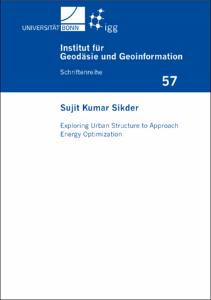Sikder, Sujit Kumar: Exploring urban structure to approach energy optimization : The case of residential settlement development in Dhaka city, Bangladesh. - Bonn, 2017. - , . In: Schriftenreihe / Institut für Geodäsie und Geoinformation, 57.
Online-Ausgabe in bonndoc: https://hdl.handle.net/20.500.11811/1674
Online-Ausgabe in bonndoc: https://hdl.handle.net/20.500.11811/1674
@phdthesis{handle:20.500.11811/1674,
author = {{Sujit Kumar Sikder}},
title = {Exploring urban structure to approach energy optimization : The case of residential settlement development in Dhaka city, Bangladesh},
school = {},
year = 2017,
series = {Schriftenreihe / Institut für Geodäsie und Geoinformation},
volume = 57,
note = {The concept of energy optimization in urban development has the potential to address many urban challenges besides local energy concerns. Past research has attempted to combine the cross-cutting issues of urban planning, energy planning, and local urban sustainability. The gaps that collectively remain in scientific progress necessitated the adaptation of different proposals for energy optimization in urban development. This study conceptualized the interrelationships of urban structure and energy aspects. It has established an integrated planning framework and drafted a simple decision support tool for urban professionals, especially in the local context of Dhaka, one of the fastest growing large cities in the developing countries.
Taking both urban and neighborhood scale study units, explorative and empirical approaches have been adapted to conduct a spatial analysis on a large dataset of building structures and a systematic evaluation of the urban planning process. First, cell-based spatial analytics demonstrate that the urban development pattern has less CBD dependency and a more polycentric urban form, dominated by residential land use. Although very small, mixed use areas can facilitate energy-efficient urban development. The residential neighborhood structure was analyzed further — focusing on urban form, electricity consumption, working mobility, resident's lifestyle and renewable energy potential. In this research experience, the physical structure related indicators are possible to measure with minimum effort, but energy aspects are more difficult and need to be addressed by urban stakeholders. Second, the comprehensive urban planning process was evaluated after establishing a conceptual framework called the "EnUp" model. The findings suggest the adoption of the "EnUp" model is both possible and necessary for cities like Dhaka. Finally, the study results directed the design of a "eNoP-DHAKA" tool that could support energy-optimization in urban residential settlement development. The drafted tool demands further work to synthesize thresholds and generalizations in combination with more case studies; however, the methodological approach and research findings have great potential to explain many urban development and energy aspects. The quantification and visualization of a large-scale building structure dataset with the integration of open data could be effectively promoted urban decision-makers formulate better policy and strategies to decide "where to allow or encourage what".
This research initiated a scientific discussion of approaches to energy-concerned urbanization especially in the context of one of the largest cities in the developing countries. The explorative insights evolved on urban spatial structure, workable conceptual framework, stakeholder's participation, renewable energy potential and a simple decision support tool for urban stakeholders.},
url = {https://hdl.handle.net/20.500.11811/1674}
}
author = {{Sujit Kumar Sikder}},
title = {Exploring urban structure to approach energy optimization : The case of residential settlement development in Dhaka city, Bangladesh},
school = {},
year = 2017,
series = {Schriftenreihe / Institut für Geodäsie und Geoinformation},
volume = 57,
note = {The concept of energy optimization in urban development has the potential to address many urban challenges besides local energy concerns. Past research has attempted to combine the cross-cutting issues of urban planning, energy planning, and local urban sustainability. The gaps that collectively remain in scientific progress necessitated the adaptation of different proposals for energy optimization in urban development. This study conceptualized the interrelationships of urban structure and energy aspects. It has established an integrated planning framework and drafted a simple decision support tool for urban professionals, especially in the local context of Dhaka, one of the fastest growing large cities in the developing countries.
Taking both urban and neighborhood scale study units, explorative and empirical approaches have been adapted to conduct a spatial analysis on a large dataset of building structures and a systematic evaluation of the urban planning process. First, cell-based spatial analytics demonstrate that the urban development pattern has less CBD dependency and a more polycentric urban form, dominated by residential land use. Although very small, mixed use areas can facilitate energy-efficient urban development. The residential neighborhood structure was analyzed further — focusing on urban form, electricity consumption, working mobility, resident's lifestyle and renewable energy potential. In this research experience, the physical structure related indicators are possible to measure with minimum effort, but energy aspects are more difficult and need to be addressed by urban stakeholders. Second, the comprehensive urban planning process was evaluated after establishing a conceptual framework called the "EnUp" model. The findings suggest the adoption of the "EnUp" model is both possible and necessary for cities like Dhaka. Finally, the study results directed the design of a "eNoP-DHAKA" tool that could support energy-optimization in urban residential settlement development. The drafted tool demands further work to synthesize thresholds and generalizations in combination with more case studies; however, the methodological approach and research findings have great potential to explain many urban development and energy aspects. The quantification and visualization of a large-scale building structure dataset with the integration of open data could be effectively promoted urban decision-makers formulate better policy and strategies to decide "where to allow or encourage what".
This research initiated a scientific discussion of approaches to energy-concerned urbanization especially in the context of one of the largest cities in the developing countries. The explorative insights evolved on urban spatial structure, workable conceptual framework, stakeholder's participation, renewable energy potential and a simple decision support tool for urban stakeholders.},
url = {https://hdl.handle.net/20.500.11811/1674}
}






